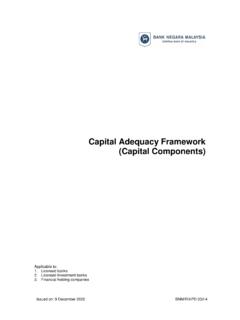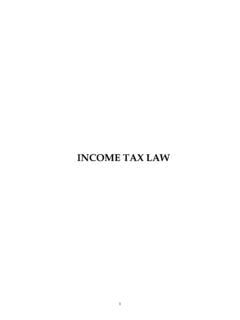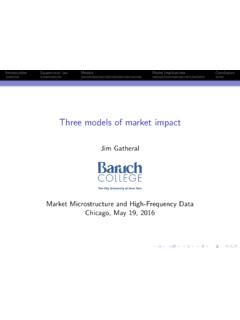Transcription of Market Equilibrium and Applications - MIT OpenCourseWare
1 Practice Multiple Choice Questions Answers are bolded. Explanations to come soon!! For more, please visit: Market Equilibrium and Applications 1. You know the following facts: a) the Boston Celtics have just won the 1989 NBA championships with the LA Lakers. Both Larry Bird and Magic Johnson, wearing Converse basketball shoes, have played magnificently. As a result, millions of young boys and girls wish to emulate them in every particular. b) Converse announces major labor strikes by 50% of their employees. What is the effect on Price and Quantity exchanged in the Market for Converse basketball shoes? A. price would increase and quantity exchanged would decrease. B. price and quantity exchanged would both decrease. C. price would increase and quantity exchanged would be indeterminate. D. price would be indeterminate and quantity exchanged would not change. E. there is not enough information to determine either price or quantity. 2. If it is observed that, in a particular Market , price has risen and quantity exchanged has increased, it is likely that: A.
2 Supply has increased. B. supply has decreased. C. demand has increased. D. demand has decreased. 3. All of the following statements about price floors are true except: A. There will be a surplus of a commodity when a price floor is set above the Equilibrium price. B. The government may have to set up a system of storage to handle the excess supply when a price floor is set above the Equilibrium price. C. If the price floor is set below the Equilibrium price, the intervention will have no effect on the Market . D. If the price floor is set below the Equilibrium price, the price must be reduced. 5. The quantity demanded will equal the quantity supplied at a free Market Equilibrium and also when: A. a price floor is established above the Equilibrium price. B. a shortage of a commodity persists. C. a price ceiling is established below the Equilibrium price. D. an effective price ceiling exists and the government is able to prevent the development of a black Market . E.
3 None of the above cause quantity demanded to equal quantity supplied. Elasticity 1. The quantity of a good demanded rises from 1000 to 1500 units when the price falls from $ to $ per unit. The price elasticity of demand for this product is approximately: A. B..16 C. D. 2. If the elasticity of demand for a commodity is estimated to be , then a decrease in price from $ to $ would be expected to increase daily sales by: A. 50% B. C. 5% D. 15% 3. Demand is said to be inelastic when: A. the percentage change in quantity demanded is greater than the percentage change in price of a good B. in a linear demand curve, quantity demanded is close to zero (given the price) so that the percentage change in quantity demanded will be very high C. the percentage change in price exceeds the percentage change in quantity demanded of a good D. a relatively small change in price results in a relatively big change in quantity demanded 10. Consumers will bear more of the burden of a tax the: A.
4 More elastic supply is. B. more elastic demand is. C. the more inelastic supply is. D. consumers always bear the burden of the tax since they pay the final price. E. none of the above. 11. An income elasticity of demand equal to 2 for a particular product means that: A. demand curves for the product slope upward. B. the product is an inferior good. C. a 10 percent increase in income will yield a 20 percent increase in the quantity sold. D. a 20 percent increase in income will result in a 10 percent increase in the quantity sold. E. (% change in Q) / (% change in P) = 2. 12. From which of the following data might you estimate a price elasticity of supply? A. a price hike from $7 to $13 causes sales to fall from 16,000 shirts to 8,000 shirts monthly. B. farmers increase soybean plantings 15 percent when the price increases 5 percent. C. Ford's production increases when Chevy sales fall because GM raises prices. D. the output of tennis balls slumps 8 percent when the prices of racquets go up 12 percent.
5 E. steel production and sales rise 18 percent when national income grows 13 percent. 16. A long-run demand curve, as compared to a short-run demand curve for the same commodity, is generally: A. more elastic B. less elastic C. of the same elasticity D. steeper if the curves are plotted against the same horizontal scale. E. none of the above. Consumer Choice 2. In a given Market , consumers' surplus would, all else equal, be increased by: A. leftward shifts of the demand and supply curves that leave price unchanged. B. a decrease in supply. C. an increase in price. D. an increase in supply. 4. Consumer surplus is: A. the area above the Market price but below the demand curve. B. a measure of the net welfare buying a particular good gives to consumers. C. the difference between the dollar amounts people would willingly pay for specific quantities of goods and the amounts they pay at Market prices. D. less for goods that are luxuries than for necessities. E. all of the above.
6 8. According to the law of diminishing marginal utility: A. marginal utility always falls with the extra consumption of a good. B. a consumer inevitably reaches a point where the additional satisfaction from consuming each additional unit of a good rises. C. a consumer inevitably reaches a point where he or she decreasingly values additional units of a good. D. utility is easily measured by dollar values. E. none of the above. Short-Run Production and Costs 1. In the short run, the firm's production curves exhibit all of the following relationships except: A. Average product of labor (APL) is at its maximum when marginal product of labor (MPL) is equal to APL. B. Total Product of Labor (TPL) is at its maximum when MPL=0. C. TPL begins to decrease when APL begins to decrease. D. when MPL < APL, APL is decreasing. E. MPL reaches a maximum sooner than does either APL or TPL. 2. If we know that capital is fixed and a business firm can produce 36 units of output per day with 3 workers and 44 units of output per day with 4 workers, then we know all of the following except: A.
7 The marginal product is below the average product. B. the firm has passed the point of diminishing marginal productivity. C. the average product of three workers is 12. D. the marginal product of the third worker must be greater than 8. E. we know all of the above. 5. Short run cost curves are U-shaped due to: A. increasing input prices. B. increasing marginal product. C. decreasing marginal product. D. the returns to specialization of labor that occurs at low production levels and the congestion that occurs at high production levels. E. the returns to specialization of labor that occurs at high production levels and the congestion that occurs at low production levels. 7. In the short-run, a profit-maximizing firm will produce additional units of a product as long as: A. price at least covers average fixed cost. C. total revenue is increasing. D. elasticity of demand is infinite. E. price at least covers average variable cost. 11. Which of the following does not reflect a short-run decision?
8 A. Should production be reduced when sales fall off? B. Should a plant be closed down when sales decrease? C. Should overtime be expanded when sales increase? D. Should a new plant be built if sales increase? E. all of the above reflect short-run decisions. 12. Short-run average total costs eventually rise because of: A. rising overhead costs. B. reduced incentives to work in larger plants. C. rising factor or input prices. D. diminishing marginal and average productivity of the variable input(s). E. technological inefficiency. Long-Run Production and Costs 1. We learned in class that firms minimize costs whenever they use capital and labor such that, given the output they are producing (and assuming only capital and labor are used in the production process), the ratio of the marginal product of labor (MPL) to its price is equal to the ratio of the marginal product of capital (MPk) to its price (MPL/w = MPk/i). This relationship can also be expressed as: A. MPL = MPk.
9 B. MPL/MPk = i/w. C. MPL/MPk = w/i. D. MPL/i = MPk/w. E. none of the above. 2. Each of the following would, all else equal, cause a firm to use more labor except: A. a decrease in the price of capital . B. a decrease in the price of labor. C. an increase in the productivity of labor due to increases in the average education of the labor force. D. a decrease in the productivity of capital . 4. If the marginal product of capital is six times as large as the marginal product of labor and the price of capital is three times as large as the price of labor, for costs to be minimized: A. the price of capital must fall. B. more labor should be used and less capital . C. more capital should be used and less labor. D. more labor should be used but the use of capital should remain constant. E. the firm must increase production to reach the minimum point of the short-run average cost curve. Perfect Competition 1. At present output levels, a firm in a perfectly competitive industry is in the following position: output = 1000 units, Market price = $3, total cost = $6000, fixed cost = $2000, marginal cost = $3.
10 To achieve optimum output, the firm should: A. reduce output but keep producing. B. increase its selling price. C. leave output unchanged. D. reduce output to zero. E. increase output but keep its price constant. 2. Which of the following is not usually a characteristic of a perfectly competitive industry? A. no individual firm has any significant amount of Market power. B. the Market demand curve is perfectly elastic. C. any individual firm can increase its production and sales without affecting the price of the good. D. existing firms cannot bar the entry of new firms. E. all of the above are characteristics of perfectly competitive industries. 3. A competitive firm's demand curve is determined by: A. firm demand and firm supply. B. the price set by the individual firm. C. Market demand and Market supply. D. the level of the firm's short-run average total cost. E. the MC curve above average variable cost. 4. At present output levels, a perfectly competitive firm is in the following position: output = 4000 units, Market price = $1, fixed costs = $2000, total variable costs = $1000, marginal cost = $ This firm is: A.
















